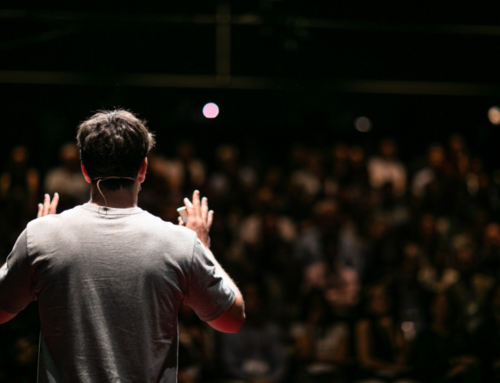This post is the second in a series on the basic building blocks of a great speech.
You’ve researched your audience, asked the right questions, and learned the particulars of the occasion. You’re ready to get started actually creating the speech.
The most important moments of a speech are the 2-3 minutes at the opening, and the closing. We’ll get to the closing (in part 6), but let’s nail those first couple of minutes now. At the opening, the audience is fresh, full of hope, and paying close attention.
That’s where most speakers go wrong.
They take one of two paths, typically, and neither one of them is good. First, they try the “let me tell you about myself” approach. Why is that wrong? Because the audience members are interested in what’s in it for them, not your biography. They really don’t want a commercial pitch, either, so don’t tell them about your company. Bottom line, they’re ready to pay attention – but to something that matters to them.
Second, speakers try the throat-clearing approach. “Great to be here. Hi, Joe! How is everyone today? Wasn’t that a great breakfast?” Why is that wrong? Because while it’s inoffensive, it’s not very engaging, and you’re squandering the most precious moments of your speech on fluff.
There is a better way. Don’t talk about you. Don’t talk about nothing. Instead, frame the talk. Frame it in a fascinating, high-level, intriguing way. Frame it in 2-3 minutes. Frame it with a question, a summary, a video, or – best of all – a story. Frame it with some kind of relevant audience interaction. But the point is to set up the rest of the talk so that the audience knows what’s in it for them, why they’re there, and is intrigued to hear more.
Don’t put up an agenda slide. That’s boring. Framing for losers. Get your creativity going and come up with something that intrigues and yet is relevant.
For an example of a nice story that perfectly sets up the rest of the talk, here’s an old clip from a wonderful speaker who died a few years ago, Leo Buscaglia. Leo does indulge in a little throat clearing at first, but he gets to the story quickly. It would have been even better if he had walked out, paused for 3 seconds, and launched directly into the story.
This particular clip begins with an introduction provided by the public television station; you’ll need to skip ahead to 1:06 when Leo walks out on stage to see the actual beginning of the speech.
Note how Leo’s story tells us the talk is going to be about love, and implies cleverly that love (like faith) is simple — the theme of his talk. Yet, the story doesn’t give away the details of how love is simple. It leaves us wanting to hear more.
That’s how you start a speech.








The Magnificent 7 – part 2!
What a wonderful speaker, hadn’t come across him before, thanks for intro. I love the way he jokes about his jacket and the takes it off and undoes his tie. His facial expressions and body language just draw you towards him, he is welcoming, warm and as you say leaves you wanting more.
I like the way that you use the idea of “framing the start” such an important part of a speech. I recently wrote on using a surprise as a way to “frame” a start. http://peterbillingham.com/how-to-start-a-speech/ So many speakers “blah, blah, blah” at the beginning and lose everyone before they have even started!
Thanks for sharing the love, love, love … love!
Peter — thanks for the comment and the link to your blog — great post on “Suprisology” Read Peter’s post and put a surprise in your speech. I’d be careful about approaching acquaintances wearing a mask and wielding pliers, however:-)